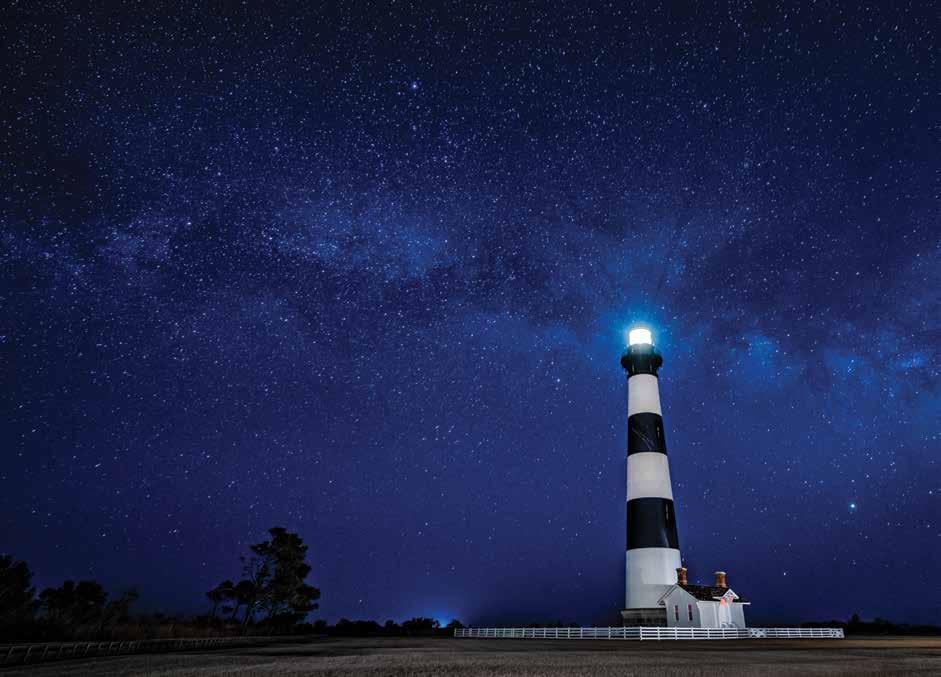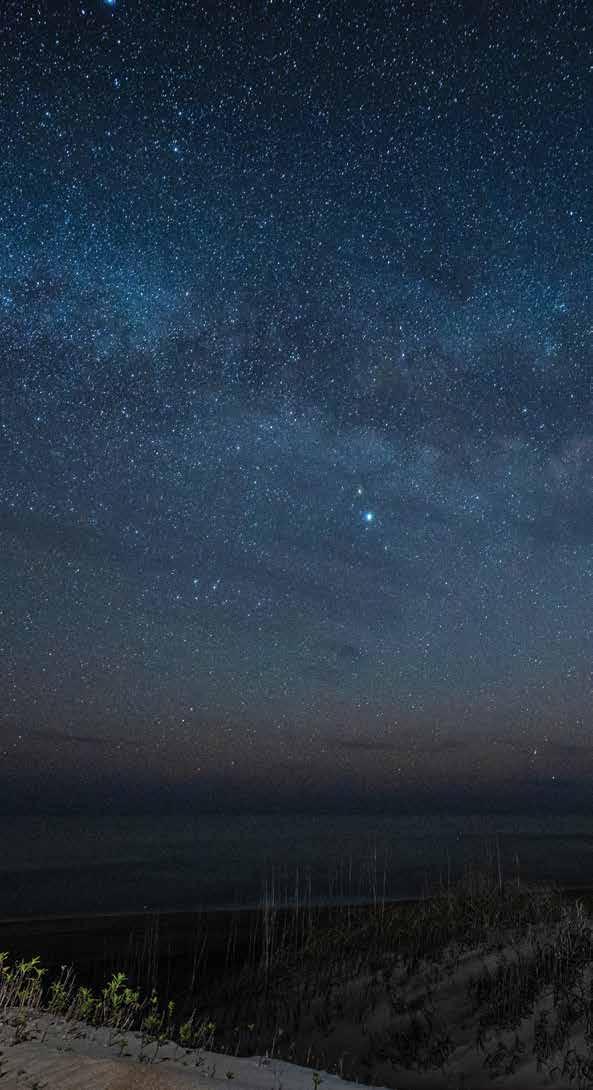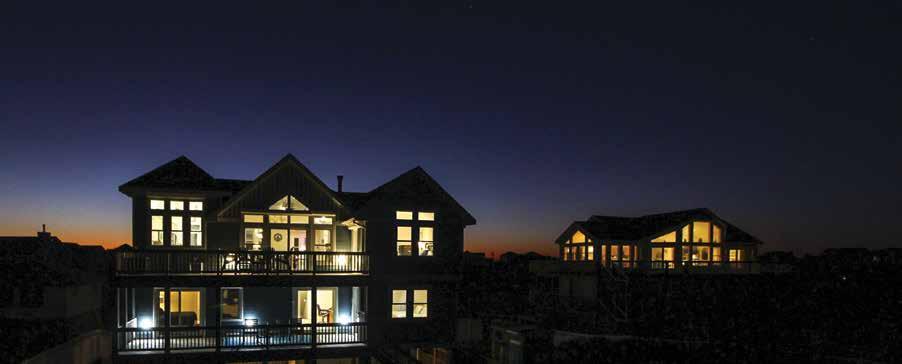
5 minute read
OUTDOORS
A WORLD
Above
Advertisement
The night sky sparkles above Bodie Island Lighthouse. Photo courtesy of John McCord.
The dark sky could bring tourists from all over to enjoy stargazing and animal watching along the Outer Albemarle Peninsula.
BY ARABELLA SAUNDERS
Eastern North Carolina is home to vinegar-based barbeque sauce, boiled peanuts and – somewhat lesser known – some of the darkest skies on the entire East Coast.
In 2018, North Carolina Land of Water (NC LOW) and the nonprofit A Time for Science Learning Center joined forces on a new initiative called the Night-Scape Resource Project in order to better understand the night skies and the nocturnal environment of the four counties – Dare, Tyrell, Hyde and Washington – that make up the Outer Albemarle Peninsula (OAP).
Led by East Carolina University professor and NC LOW chair Dr. Stanley Riggs, the study concluded that the OAP is the largest area of public lands – approximately 758 square miles – with the darkest night skies between Boston and Miami, making it ripe for ecotourism opportunities.
FROM JULY 2018 THROUGH MAY 2019, Stanley and a team of Coastal Studies Institute-affiliated scientists, staff and student volunteers surveyed sites in the region on 11 new and 11 full moon nights. Altogether, the researchers made 250 visits to 83 sites.
Kira Foster is an Outer Banks local and an environmental studies student at Appalachian State University. In the summer of 2018, Kira volunteered with the study and often drove from her home in Southern Shores to the woods in East Lake, where she helped record observations such as wind speed, barometric pressure, brightness, noises from wildlife and the positions of the stars.
“It was rewarding because I had been to all those places before, but I had never thought to go there at night,” Kira says thoughtfully. “I felt like I was doing something good in my field because I was helping the area where I grew up in an environmental way.”
CONTINUED ON PAGE 24


-DR. STANLEY RIGGS
A vast landscape of stars shine brightly at Coquina Beach, which is part of the Cape Hatteras National Seashore – and a location that might one day be designated an International Dark Sky Park. Photo courtesy of John McCord.
As lead investigator for the project, Stanley feels similarly. Already an internationally recognized geologist, Stanley has been researching the coastal environment of eastern North Carolina for more than 55 years – and when he’s not busy studying the natural world, he’s out enjoying it on his boat.
But it wasn’t until a few years ago that he pulled his focus from the water and the lands he’d been writing about for his entire career and decided to spend some time looking up.
“It dawned on me that this is a natural resource for this region that we take for granted,” Stanley says. “Everybody knows it, but we don’t think about it. There’s actually a large business in astronomy – and the public is interested in the night sky.”
On April 3, Stanley and four co-authors published their 156-page report entitled “Night-Scape Resources: Northeastern North Carolina Coastal System.” The team concluded that this region is an exceptional nightscape resource for four main reasons: 1) the expansive area of public wetlands are remote and subject to minimal human activity; 2) the darkness of the night sky is tourism-worthy due to the increasing presence of light pollution throughout other areas in the country; 3) the 360-degree view of the horizon is ideal for viewing sunsets and sunrises; and 4) there’s a vast array of nocturnal wildlife.
“There’s the astronomical and the ecological,” Stanley explains. “The sunsets, the sunrises and the moonrises are phenomenal, but the sounds of all the animals that are out carousing in the swamps at night are really spectacular, too.”
ECOTOURISM IS TOURISM DIRECTED TOWARD natural and oftentimes threatened environments that’s intended to support conservation efforts. And since the OAP is one of the only starry vistas left on the Eastern Seaboard due to increasing light pollution, Stanley thinks it’s the perfect attraction for visitors from bustling cities.
While the nightscape report lays the groundwork for potentially earning this region the designation as an International Dark Sky Park, Stanley acknowledges that the official process for that could take years and would require a community-wide effort from county officials, business owners and residents.
Still, it’s something worth bearing in mind, and Stanley ultimately hopes that the study will serve as a resource for those looking to responsibly incorporate the OAP’s dark skies and nocturnal environment into a variety of ecotourism programs.
Because not only can the region provide visitors with clear views of the constellations, but the area’s diverse nocturnal wildlife – including bears, packs of coyotes and the rare red wolf – is tourism-worthy as well.
“In the winter, there’s hundreds and thousands of tundra swan and geese in the air, and it’s an incredible sound,” Stanley says. “In the daytime you can see them, but at night you can sit back and hear them.”
YOUR OUTER BANKS EXPERTS



1.800.334.1000 SouthernShores.net

David Watson 252.473.7990

For the best advice about Outer Banks real estate call one of our knowledgable agents today.
Terry Zeigler 252.305.2521
Charlie Byrne 252.202.2642

Mike Ross 252.202.4444 Jim Forrest 252.256.0528 Manny Medeiros 252.202.1862
Cory Taylor 252.599.1721 Janet Owen 252.599.1786
Jim Stone 252.256.3131 John Wojcik 252.473.7060










